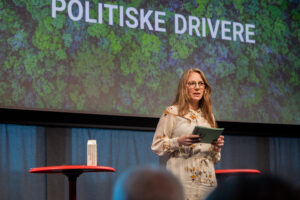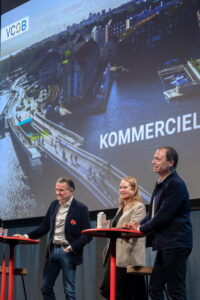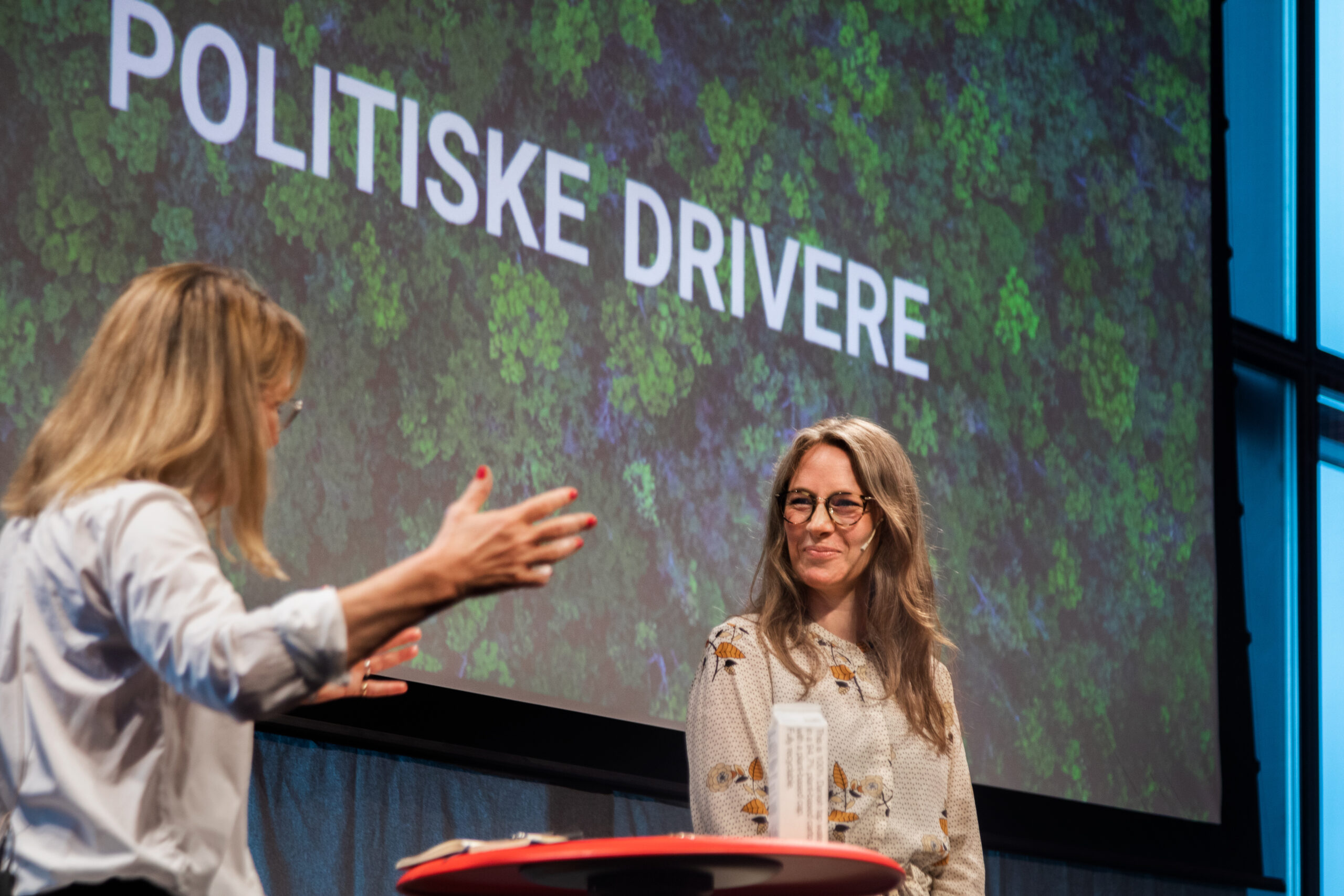At a recent conference on circularity in the built environment, BLOXHUB and VCØB Community welcomed key speakers to outline the opportunities and challenges within the political, commercial, and practical spheres of the circular economy.
The circular transition of the built environment moves too slowly, so what will it take to speed up and scale up the process? That was one of the main questions at a conference we held Friday, May 20 alongside VCØB Community – a community of companies and organizations within the Danish built environment committed to making a circular transition.
The conference focused on three different aspects of the circularity discussion: political, commercial, and practical drivers, and speakers included the Minister for Environment, Lea Wermelin, former Minister for Higher Education and Science and investor, Tommy Ahlers, and members of the VCØB community among others.
After introductions from BLOXHUB’s Science Director, Pernille Berg, and co-founder of VCØB Community, Tine Lange, the Minister for Environment, Lea Wermelin, took to the stage, addressing “how we – brick by brick, building by building – can make the building industry much more circular.”
Political Drivers: New Framework to Support Circularity
A recurring theme of the conference was that it takes many different people, professions, and perspectives to ensure a circular transition. This resonates with the idea behind VCØB Community, which aims at gathering many different actors, and with the work of BLOXHUB: we need an interdisciplinary approach, and we need collaboration to face the challenges of sustainable urbanization and the circular transition.
It also resonated with the Minister for Environment, Lea Wermelin, who addressed the fact that it will take collaboration between various ministries to make a political framework for furthering the circular agenda. She highlighted the strain on the planet’s resources, which can be traced back to the built environment:

The Minister for Environment, Lea Wermelin, talked about the importance of the circular transition. Photo: Lisbeth Hjorslev
40% of resources are used in the building industry, and we are currently using more than the planet can account for. If everyone lived like people in Denmark, we would need 3 additional Earths. Furthermore, 1/3 of all waste in Denmark comes from the building industry. But – as the Minister continued – this “also shows how much there is to gain from going circular, ensuring that resources aren’t wasted.”
To support the circular transition and the engagement and goodwill that she experiences from the building industry towards circularity, the Government has produced a national strategy for sustainable construction and an action plan for circular economy. These include requirements for selective demolition, making overviews of resources in existing buildings, and planning for further use. “We need to see buildings as material banks, where the resources are savings that can be withdrawn and reinvested in new buildings,” the Minister said.
Lea Wermelin also addressed the urgency of the matter and the need to scale up. This can only be done through collaboration and will take effort from politicians as well as practitioners, she said, applauding all the circular projects already going on and asking the participants of the conference for continued engagement:
“We are not there yet, but we are on our way. … The circular transition is a challenge throughout the world, and the demand for solutions will only increase. This is an opportunity to create Danish jobs and to show the world how we can build sustainably. We need your ideas, your creativity, and your courage.”
Commercial Drivers: Circularity as an Investment Opportunity
Another thing that is needed to speed up and scale the circular transition is a willingness to invest. To discuss the commercial drivers of the circular transition former Minister for Higher Education and Science and investor, Tommy Ahlers, Director of Partnerships at Lendager, Ditte Lysgaard Vind, real estate investor and chairman of Thylander Group, Lars Thylander took to the stage for a panel discussion. The panelists agreed on the importance of supporting sustainable and circular initiatives in the built environment, but they also pointed out challenges.

From left to right: Lars Thylander, Ditte Lysgaard Vind, and Tommy Ahlers. Photo: Lisbeth Hjorslev
One of the things that Tommy Ahlers called for was circular business cases with a clear potential for upscaling. With his new investment company DLUV – Don’t Look Up Ventures, named after the film starring Leonardo DiCaprio, he is looking to direct investments into the physical world and support sustainable change. Seeing that the building industry is a big part of both the sustainability discussion and the global economy, it’s a good place to start.
“We’re doing it out of a moral obligation – everybody needs to change their way of doing things. But it’s for the planet’s sake as well as our own because I also really believe there will be great business opportunities in this area,” he said, but pointed out that the many layers of decision making within the built environment can scare off potential investors such as himself.
Lars Thylander has been in the business for several decades with his real estate investment company Thylander Group, and to him the best approach to sustainability is quality: Buildings made from high-quality materials and methods can sustain for many years, making it possible to reuse entire buildings, instead of select resources from it. Investing in property should focus on long-term returns, not just the first year returns to ensure quality, he said. He is curious and interested in the new circular movement, but like Tommy Ahlers, he is still waiting to see more ideas and cases come to life.
At Lendager, they work with circularity in different ways, Ditte Lysgaard Vind explained. One is their pioneering architecture and another is their spinoff company A:GAIN, which seeks to minimize material consumption within the construction industry through scalable waste-based products. Ditte Lysgaard Vind emphasized curiosity as an approach to circularity, and that sustainability and aesthetics can easily go hand in hand. These factors can help make circular construction attractive for investors and the people who live in it.
Practical Drivers: Existing Initiatives Within the VCØB Community
The last of the conference keynote speakers was Lene Brix from Circle Bank – a grand solutions project from BLOXHUB’s Circular Built Environment Network. During the past year, Circle Bank has worked on making concrete and databased prototype solutions for creating a circular marketplace within the Danish built environment. This entails creating a decision support tool, a material bank and exchange, as well as ensuring the proper documentation of resources through a material passport, all gathered in a digital platform for the industry.
The aim is to ease and scale the circular transition of the built environment by giving concrete tools to assess the resources of a given building, enable a better overview of existing materials for reuse, and help ensure better documentation and standardization of materials through data. By aiming the tool at different stages in building processes, the entire value chain can be connected in the same digital platform, making the processes more transparent for everyone.
A lot of the work with Circle Bank is still underway or at a prototype stage, and Lene Brix encouraged people to come forth if they wanted to collaborate. “This can only happen if we work together. Nobody can do it on their own, not in Circle Bank or in the market in general,” Lene Brix said and connected the efforts of Circle Bank with concerns for planetary boundaries and the rapid increase in building activity over the last century:
“The reason that we’re even talking about this here today is that we have forgotten that we are part of an ecosystem and that we have a responsibility to that ecosystem.”
The last part of the conference was spent in break-out sessions with three different circular projects collaborations from the VCØB Community, inspiring participants with successful cases from the industry. Kasper Sørensen from Søndergaard and Jens Thamdrup from ATP Ejendomme talked about a selective demolition project, Tim Riis Tolmann from Lendager and Jan René Rasmussen from Gladsaxe Municipality elaborated on Denmark’s first circular kindergarten called Børnehuset Svanen (the Swan), and Klaus Birk from Saint Gobain and Thomas King from Kingo shared their experiences with reused plaster for industrialized plasterboards.
VCØB Community launched earlier this year at an event in BLOXHUB, and already the community consists of about 100 companies and organizations. Activities include events and knowledge sharing e.g., through webinars, podcasts, and green papers. Check out VCØB Community and become a member here.
VCØB Community is supported by Realdania and Grundejernes Investeringsfond.



